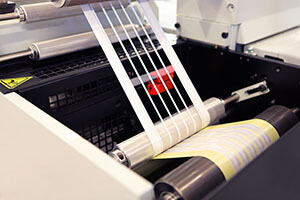The Most Common Release Film Problems and Solutions
2021/07/25

1. Poor Demolding:
The main function of the release film is to allow the substances attached to it to be easily detached. If the demolding force is uneven or insufficient, it may cause too strong bonding between the die-cut product or the coating product and the release film, making them difficult to separate. Under this circumstance, the product might be torn or leave residues, affecting the appearance and performance of the product.
Solution:
The demolding force can be improved by choosing the appropriate release agent and/or adjusting the surface treatment of the release film. For example, by increasing the concentration of the release agent or using a release agent with a higher demolding force. Also, the parameters of die-cutting or coating can be optimized, such as pressure and speed, to reduce the pressure on the release film and improve the effect of demolding.
2. Surface Defects:
Defects on the surface of the release substrate, such as dust, scratches, bubbles, etc., may be transferred to the product during the die-cutting or coating process, causing surface defects on the product. Similarly, wrinkles, pits, or wavy deformations of the release substrate itself may also cause corresponding defects on the product surface. These defects can affect the appearance quality of the product and may affect its functional performance.
Solution:
Surface defects can be reduced by improving the manufacturing and processing of the release substrate. For example, by adding cleaning steps or using better filtration equipment to remove dust and other impurities.
3. Size Deformation:
During the coating or die-cutting process, the release film may be subjected to stresses such as stretching or compression, causing its shape or size to deform. If this deformation exceeds the allowable range, it may reduce the dimensional accuracy of the product, affecting its assembly or use. For instance, the shape of the die-cut product may not match the design, or the thickness of the coated product may be uneven.
Solution:
The parameters of die-cutting or coating can be optimized, such as reducing machine speed, lowering temperature, or adjusting application pressure, to reduce the stress on the release film. Also, a film material with higher strength and stability can be chosen to resist deformation.
4. Adhesion Issues
If the surface energy of the release backing is insufficient, it may cause insufficient adhesion between the coating material and the backing. This could cause the coating material to separate during subsequent steps such as coating, baking, die-cutting, and even cause shedding during the use of the product. This directly affects the performance and lifespan of the product.
Solution:
The adhesion can be improved by adjusting the surface treatment of the release backing. For example, by increasing the surface energy or changing the surface roughness. Also, a release agent or release backing with better compatibility with the coating material can be chosen.
5. Uneven Film Thickness:
If the thickness of the release film is uneven, it will lead to inconsistent thickness of the product after coating or die-cutting. For products that need precise control of thickness (like electronic components, optical films, etc.), this might lead to unstable performance or even failure.
Solution:
This usually requires improving the manufacturing process of the release film to ensure the uniformity of the film. For instance, adjusting the parameters of casting equipment, controlling the temperature and flow rate of the film material, or using more accurate thickness control equipment. For the coating process, it may be necessary to optimize the coating equipment and parameters, like using a better scraper, adjusting coating speed, and pressure, etc.
6. Release Agent Migration
The release agent on the release film may migrate from the film surface to the coating material or die-cut product during the die-cutting or coating process. This migration of the release agent might reduce the surface energy of the coating material, leading to reduced adhesiveness with subsequent materials (such as adhesives, inks, etc.). At the same time, the migration of the release agent may also change the surface properties of the coating material or die-cut product, such as its optical properties, electrical properties, etc.
Solutions:
- Choose the right release agent: Choosing a release agent with low migration or one that is compatible with the coating material can reduce the risk of release agent migration.
- Optimize the coating process: Adjusting coating parameters, such as reducing coating speed, controlling drying time and temperature, can minimize the migration of the release agent.
- Change the treatment method of the release film: For example, special surface treatments can be used to inhibit the migration of the release agent, or a barrier layer can be coated on the release film to prevent release agent migration.
- Increase product tolerance: If possible, a coating material or subsequent processing technique with better tolerance to release agent migration can be chosen.
Releated Products: Fluorosilicone Release Liner
Category
